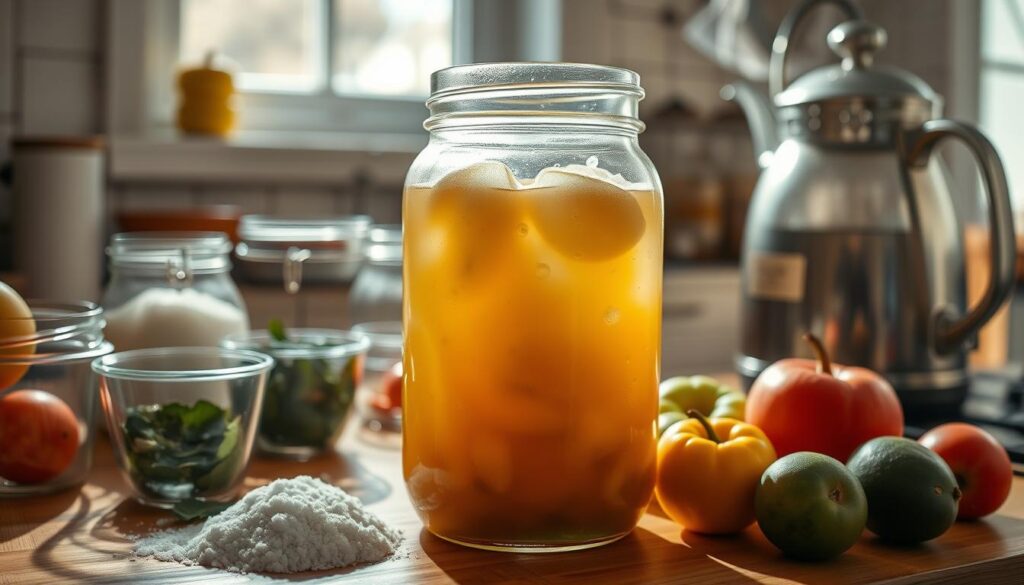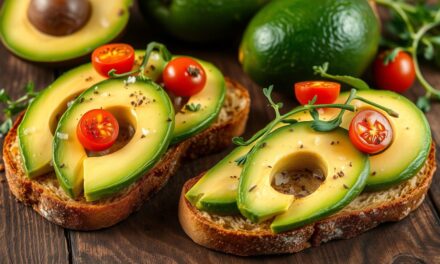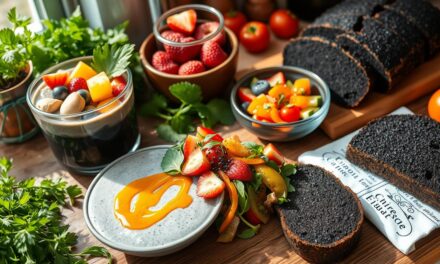Australians drink an amazing 3 million litres of kombucha every year. This fermented tea is loved for its tasty flavours and health perks. If you’re keen to try it or already love it, this guide will show you how to make it at home.
Key Takeaways
- Kombucha is a fermented tea that is rich in probiotics and other health benefits.
- Brewing your own kombucha at home is easy and cost-effective.
- You’ll need a SCOBY (symbiotic culture of bacteria and yeast), tea, sugar, and a few basic tools to get started.
- Proper temperature control, timing, and maintenance of your SCOBY are essential for brewing success.
- Experiment with different flavours during the second fermentation process to create your perfect kombucha.
Understanding Kombucha: A Fermented Tea Revolution
Kombucha, a fermented tea, has become popular in Australia. It’s an ancient drink with modern appeal. It offers health benefits and a refreshing taste.
The Origins and Health Benefits of Fermented Tea
Kombucha comes from ancient China. It was valued for its gut health benefits. The fermentation process creates a drink full of beneficial bacteria, making it a great probiotic drink.
How Fermentation Creates Probiotic Magic
The magic of kombucha lies in its fermentation. A mix of bacteria and yeast (SCOBY) turns tea into a fizzy, probiotic-rich drink. This process adds gut-friendly bacteria to the beverage.
Why Australians Are Embracing This Ancient Drink
Australians are now focusing on gut health. Kombucha is a hit because it’s a healthy alternative to sugary drinks. It’s a tasty way to add beneficial bacteria to your diet.
| Benefits of Kombucha | Key Nutrients |
|---|---|
| Promotes Gut Health | Probiotics, Organic Acids, B Vitamins |
| Boosts Immune Function | Antioxidants, Enzymes |
| Supports Detoxification | Glucuronic Acid, Gluconic Acid |
| Enhances Energy Levels | B Vitamins, Caffeine (from tea) |
“Kombucha has become a staple in my daily routine. It’s the perfect way to keep my gut happy and energized throughout the day.”
– Sarah, Kombucha Enthusiast
Essential Equipment and Ingredients for Brewing Success
Making your own kombucha is all about the right DIY brewing tools and ingredients. From the fermentation vessel to the tea, each part is vital. They help create a thriving scoby culture and a tasty, probiotic drink.
You’ll first need a top-notch scoby to start the fermentation. This gelatinous disc is the kombucha’s heart. It turns sweet tea into a fizzy, tangy drink. Getting a healthy scoby culture from a reliable source is crucial for a great first batch.
Then, you’ll need a good brewing container, like a glass jar or ceramic crock, with a 4-litre diameter. It should have a wide mouth for air and easy access. Don’t use metal containers, as kombucha’s acidity can harm the flavour.
- High-quality black or green tea, such as Assam or sencha
- Organic cane sugar or honey for feeding the scoby culture
- A pH-testing strip to monitor the acidity levels during fermentation
- A clean, breathable cover, such as a coffee filter or a thin cloth, to keep out dust and pests
- A long-handled, non-metal utensil for stirring and removing the scoby
With these key DIY brewing tools and ingredients, you’re ready to make your own kombucha. It will be full of probiotics and have a refreshing taste.
The SCOBY: Your Kombucha’s Living Engine
The scoby culture is at the heart of every great kombucha brew. It’s a mix of beneficial bacteria and yeast. This living organism turns simple tea into the fizzy, probiotic drink we all love.
How to Source a Quality SCOBY
Getting a healthy scoby is the first step in making kombucha. You can grow one from a store-bought kombucha or buy it from a trusted supplier. Look for a firm, gelatinous scoby with a smooth texture. Stay away from any that are discoloured, shrivelled, or damaged.
Maintaining SCOBY Health
- Feed your scoby a balanced diet of black or green tea, sugar, and filtered water.
- Keep the brewing temperature between 20-26°C for optimal conditions.
- Protect your scoby from direct sunlight to avoid damage.
- Regularly remove older scoby layers to keep the younger, healthier ones.
Signs of a Healthy Culture
A healthy scoby is smooth, rubbery, and off-white. It grows new layers on top. If it’s discoloured, mouldy, or smells bad, it’s time to get a new one.
| Healthy SCOBY Characteristics | Unhealthy SCOBY Characteristics |
|---|---|
| Smooth, rubbery texture | Slimy, discoloured or moldy appearance |
| Creamy, off-white colour | Unusual or unpleasant odour |
| Forming new layers on top | Shrivelled or damaged structure |
Keeping your scoby healthy is key to making great kombucha. By knowing the signs of a thriving culture and caring for it right, you’ll make your own probiotic drink at home.
Step-by-Step Guide to Homemade Kombucha
Making your own homemade kombucha is rewarding and saves money. It’s perfect for both newbies and seasoned DIY brewing fans. This guide will help you make your own tasty, fermented tea.
- Prepare the Tea: Start by steeping black or green tea leaves in boiling water. Let it cool down to room temperature. Use 1 tea bag or 1-2 teaspoons of loose-leaf tea for every 1 cup of water.
- Add the Sugar: Mix in plain white sugar, about 1/4 cup for every 1 cup of tea. Stir until it’s fully dissolved.
- Introduce the SCOBY: Gently put your SCOBY (Symbiotic Culture of Bacteria and Yeast) into the sweet tea. Add some liquid from your last batch too.
- Cover and Ferment: Cover the container with a breathable cloth or coffee filter. Use a rubber band or lid to keep it in place. Let it ferment at room temperature for 7-14 days.
- Taste and Adjust: Check the kombucha’s tartness by tasting it. When it’s just right, it’s time for the second fermentation.
This easy homemade kombucha guide will get you started on enjoying a healthy drink. Remember, success comes from patience and paying attention to details. Happy DIY brewing!
“Kombucha is a delicious and healthful way to nourish your body with natural probiotics and antioxidants.”
Mastering the First Fermentation Process
Making the perfect homemade kombucha is like an art. The first fermentation stage is key to all the flavour. As you start your DIY brewing adventure, learning this step well is vital for a tasty, probiotic drink.
Temperature Control Tips
Keeping the right temperature is key for the fermented tea to grow well. Aim for 20-26°C (68-79°F) during fermentation. If the temperature changes too much, it can mess up the yeast and bacteria balance.
Timing Your Brew Perfectly
- The first fermentation usually takes 7-14 days, depending on the temperature.
- Check the flavour and acidity often, as it will get more tart and complex.
- Try the brew every few days to get the sweetness and tartness just right.
Troubleshooting Common Issues
- Mold or slime formation: Make sure the SCOBY is healthy and the area is clean and sterile.
- Off-flavours: Adjust the fermentation time or temperature to get the taste you want.
- Slow fermentation: Check the SCOBY’s health and add more sugar or starter liquid if needed.
Mastering the first fermentation is the first step to making great kombucha. It’s full of flavour and good for your gut. Be patient, watch closely, and be ready to make changes. The homemade fermented tea will be worth all the effort.
Creating Flavour Combinations for Second Fermentation
Homemade kombucha fans can get creative in the second fermentation stage. This is a great time to try different fruits, herbs, and spices. You can make unique, low-sugar drinks that you’ll love.
Start by adding fresh or dried fruits like berries, citrus, or tropical ones. Herbs like mint, ginger, and lavender add great smells and depth. For a warm taste, try cinnamon, cardamom, or a bit of chili pepper.
- Strawberry and basil
- Mango and turmeric
- Raspberry and rosemary
- Pineapple and ginger
- Blueberry and lavender
Try out different mixes and amounts to find what you like best. The second fermentation makes flavours stronger, so start small and add more as needed.

Exploring second fermentation is fun and rewarding. Making your own unique, low-sugar drinks is a great way to enjoy this ancient tea.
Storage Tips and Shelf Life Guidelines
Keeping your homemade kombucha fresh is key. It helps keep the probiotics and taste great. Here are some tips to keep your fermented tea drink fizzy and tasty.
Proper Bottling Techniques
When you bottle your kombucha, make sure it’s clean. Use sterilised bottles and lids. Leave about an inch at the top for carbonation.
Seal the bottles well but don’t overdo it. Too tight can cause the bottle to burst.
Maintaining Optimal Conditions
Keep your homemade kombucha in a cool, dark spot. A pantry or cellar works well. Stay away from sunlight to keep the bacteria and flavour good.
Keep the temperature between 18-25°C. This is the best range for your drink.
When to Start a New Batch
- Check how long your fermented tea lasts. Homemade kombucha stays fresh for 2-4 weeks if stored right.
- Watch for signs it’s not fermenting as much. Less carbonation or a less lively taste means it’s time.
- When you’re almost out, it’s time to make more. This way, you always have some on hand.
By following these tips, you can enjoy your homemade kombucha for a long time. Cheers to always having this tasty, healthy drink ready!
Common Mistakes and How to Avoid Them
Making perfect DIY brewing kombucha is rewarding but comes with challenges. As a home brewer, you’ll want to avoid common mistakes. Knowing these mistakes and how to avoid them will help your homemade kombucha always be perfect.
One big issue for new brewers is not taking care of the scoby culture right. Not looking after the SCOBY (symbiotic culture of bacteria and yeast) can cause bad fermentation and taste. It’s important to check the SCOBY’s health and adjust your brewing as needed.
- Ensure the SCOBY is free of mould or discolouration
- Provide the SCOBY with the right balance of nutrients and oxygen
- Maintain optimal temperature conditions throughout the fermentation
Another mistake is rushing the fermentation process. Kombucha needs patience, as the first fermentation can take 7-30 days. Rushing it can make the drink too sweet or not fermented enough.
| Mistake | Solution |
|---|---|
| Inadequate temperature control | Maintain a consistent temperature between 68-85°F (20-29°C) for optimal SCOBY health and fermentation |
| Contamination from poor sanitisation | Thoroughly clean and sanitise all equipment before each batch to prevent unwanted microbes |
| Ignoring fermentation progress | Regularly taste and test your homemade kombucha to ensure it reaches the perfect balance of sweetness and acidity |
By avoiding these common mistakes and following best practices for DIY brewing, you’ll make delicious, probiotic-rich kombucha at home. With patience and attention to detail, your kombucha will impress everyone.

Health Considerations and Moderation
Kombucha, the fermented tea sensation, has won over health-conscious Australians. But it’s key to know the health ups and downs and drink it in moderation.
Kombucha is known for its gut health perks. The fermentation adds beneficial bacteria, or probiotics, to the tea. These help with digestion, nutrient uptake, and boosting the immune system.
But drinking too much kombucha can cause issues. The fizz and acidity might upset your stomach, especially if you’re sensitive. Also, kombucha has a bit of alcohol, which is something to think about if you’re watching your alcohol intake.
- Drink kombucha in moderation, as part of a balanced diet.
- Start with small amounts and increase if you can handle it.
- Watch out for signs like bloating, gas, or heartburn, and adjust your drinking.
Knowing the good and bad of kombucha lets you enjoy it as a tasty, healthy part of your life. Just remember to drink it with care and in the right amounts.
“Kombucha is a remarkable fermented tea that can provide a wealth of benefits, but it’s crucial to consume it mindfully and in moderation.”
Scaling Up: From Home Brewing to Small-Batch Production
As your love for making kombucha grows, you might want to make more. Moving from making it at home to a small-batch production is exciting. It’s a journey that can be very rewarding.
Scaling up needs careful planning. First, check if your equipment can handle more kombucha. You might need bigger brewing tanks, better temperature control, and new bottling gear.
- Get larger fermentation tanks to hold more kombucha.
- Use better temperature control to keep the fermentation perfect.
- Get semi-automated or automated bottling equipment for better efficiency.
You also need to think about food safety and following the rules. Learn about the laws and get any needed permits for making kombucha on a small scale.
| Considerations | Homemade Kombucha | Small-Batch Production |
|---|---|---|
| Brewing Vessels | 1-5 gallons | 10-50 gallons |
| Temperature Control | Manual monitoring | Automated systems |
| Bottling | Manual, small-scale | Semi-automated or automated |
| Food Safety Compliance | Informal, personal | Formalized, regulatory |
By tackling these practical and legal points, you can turn your homemade kombucha hobby into a successful small-batch business. This way, you can meet the increasing demand for this healthy drink.
Conclusion
Brewing homemade kombucha is a fun and rewarding hobby. It lets you make your own probiotic-rich, fermented tea. You’ve learned how to start your kombucha-making journey.
Creating your own unique flavours is exciting. You can try different ingredients and watch the fermentation process. Homemade kombucha is not only tasty but also good for you.
This guide is for both new and experienced kombucha makers. It gives you the tools to make great kombucha at home. Enjoy the journey of finding the perfect flavours and carbonation. Cheers to your homemade kombucha adventure!





